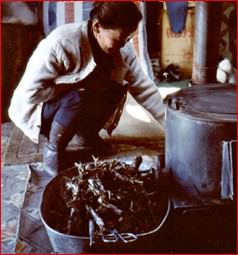DIFFICULT ISSUES
Conflicts of overgrazing and topsoil loss
As population increases, the domestic animal population to support it increases. Overgrazing is leading to the loss of grassland species and damage from erosion that is difficult to restore. This brings economic hardship for Mongolia’s herders and threatens wild grazer populations.  The nomads have always moved their herds to follow the seasonal pastures — this is the soul of their way of life. They find it very hard to come to grips with this situation. The nomads have always moved their herds to follow the seasonal pastures — this is the soul of their way of life. They find it very hard to come to grips with this situation.
In additon to the damage from animal overgrazing there is damage from inappropriate technology being applied to agricultural processes — such as using heavy machinery for ploughing the thin topsoil. Thin topsoils, low soil fertility and permafrost severely constrain the potential for intensive agriculture in Mongolia. Yet farmers are being encouraged to employ heavy, modern tractors to replace ancient plowing methods.
As we walked across the desert we noticed the fragile nature of the soils. They appeared to be thin and of course desperately dry and lacking in sufficient nutrients to support enough growth to feed the herds of cattle, sheep, goats and camels in addition to the wild animals indigenous to the Gobi.
Herdsmen and their families have lived in this inhospitable place for centuries living a nomadic lifestyle as they move about the desert in constant search of food and water. There are 25 million grazing animals in Mongolia and many of them live in the Gobi Desert.
In recent years ground water levels have dropped all across the desert not only due to drought and the normal dry Gobi climate but also due to the expansion of nomad family herds because of increasing population. We found a serious lack of wells and many wells we found were dry or nearly so.
Over-exploitation of timber resources
As in so many other areas of the Earth, there is a conflict between the people who need to utilize the available forest for timber and fuel and the conservationists who represent the interest of the wildlife that require the forest for habitat. Excessive logging and firewood collection also contributes to erosion and desertification and threatens important watersheds. Cooking is done using whatever wood can be gathered and camel dung. Excessive logging and firewood collection also contributes to erosion and desertification and threatens important watersheds. Cooking is done using whatever wood can be gathered and camel dung.
Poaching and trade in endangered species
Species are threatened not only by the loss of habitat but also by poaching and illegal trade which has increased dramatically in recent years. Species under threat include snow leopard, Gobi bear, Argali sheep, Mongolian saiga antelope and Musk deer. Until the demand for exotic furs disappears in the richer countries, the incentive will remain for native people to poach these and other endangered animals.
There is also a growing industry supporting wealthy "safari" hunters who want to collect "trophies" by killing wildlife of the Gobi. We wondered what happens if a hunter looking for an Ibex has an endangered Gobi bear amble into range of his telescopic sight. One website promoting this troublesome practice is: Mongolia Hunts.
Here is a quote from UNITRA another website in Mongolia... "Khordol Saridag Uul of Khuvsgul, Mongolian Dornod Tal and Gobi Desert are the main hunting regions of Mongolia. In these regions are found Snow Leopard, Gobi Brown Bear, Deer, Argali Sheep, Ibex and Maral Stag. Hunts for certain species of these animals are offered on a limited permit basis by the Mongolian government." Wonder what a hunting permit for Snow Leopard would cost.
As we walked 1,423 miles across the desert, we considered whether it would be kinder to beast and man if they would move north to the more lush areas of Mongolia where there would be more feed and water. It appeared to us that there was barely sufficient food and water to support the hardy indigenous animals that roam the desert that they call home.
However these herdsman families have followed the traditions of their ancestors and use the knowledge that is handed down to them concerning the land, its plants and water sources to feed their herds. To move would be unthinkable to most. New areas would be foreign to them and the learning would have to begin all over again. Also, others following their own ancestral traditions, would already live in these better grazing areas with their herds and angry clashes might occur when the newcomers would arrive from the desert with their herds.
There is no easy solution to the Gobi Desert problems of disappearing water and increased desertification. Mongolia is truly at a crossroads. increasing population, natural resource consumption, and the political, social, and economic changes now sweeping the nation threaten the future of Mongolia's remaining wild places.
|



